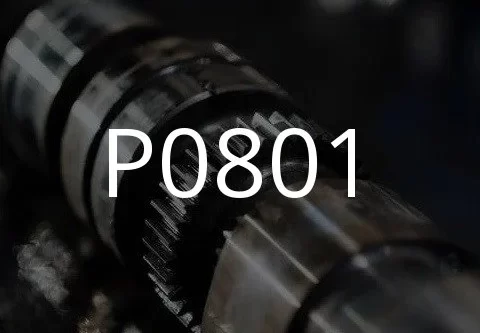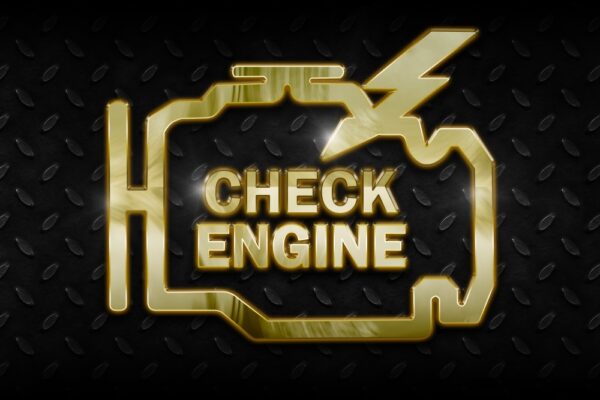
P0801 Reverse Interlock Control Circuit Malfunction
Content
P0801 – OBD-II Trouble Code Technical Description
Trouble code P0801 indicates a problem with the anti-reverse anti-reverse control circuit.
What does the fault code mean P0801?
Trouble code P0801 indicates a problem in the vehicle's anti-reverse control circuit. This means there is a problem with the mechanism that prevents the transmission from reversing, which could potentially affect the safety and reliability of the vehicle. This code can apply to both the transmission and transfer case depending on the make and model of the vehicle. If the engine control module (PCM) detects that the anti-reverse interlock circuit voltage level is higher than normal, a P0801 code may be stored and the Malfunction Indicator Indicator Light (MIL) will illuminate.

Possible reasons
Some possible reasons for the P0801 trouble code:
- Problems with electrical connections: Broken, corroded or damaged electrical wires or connectors associated with the anti-backstop control.
- Reverse lock malfunctions: Defects or damage to the anti-reverse mechanism, such as solenoid or shift mechanism failure.
- Sensor Issues: Malfunction of the sensors responsible for monitoring and controlling the reverse lock.
- Incorrect PCM software: Errors or failures in the engine control module software that may cause the anti-backstop control system to not operate properly.
- Mechanical problems in the transmission: Problems or damage to the internal mechanisms of the transmission, which may cause problems with the reverse lock.
- Transfer case problems (if equipped): If the code applies to the transfer case, then the cause may be a fault in that system.
These possible causes should be considered as a starting point for diagnosing and solving the problem.
What are the symptoms of a fault code? P0801?
Symptoms for DTC P0801 can vary depending on the specific cause and nature of the problem, some of the possible symptoms are:
- Difficulty when shifting into reverse gear: One of the most obvious symptoms is difficulty in shifting the transmission into reverse gear or the complete absence of such an ability.
- Locked in one gear: The car may remain locked in one gear, preventing the driver from selecting reverse.
- Unusual sounds or vibrations: Mechanical problems in the transmission may cause unusual sounds or vibrations when it operates.
- The fault indicator lights up: If the voltage level in the anti-reverse circuit exceeds the specified values, the malfunction indicator on the instrument panel may come on.
- Degraded transmission performance: The transmission may operate less efficiently or harshly, which may slow down shift speed.
- Transfer case reverse problems (if equipped): If the code is applied to the transfer case, then there may be problems with the vehicle reversing.
It is important to note that not all symptoms will occur at the same time, and they may depend on the specific cause of the problem.
How to diagnose a fault code P0801?
To diagnose DTC P0801, follow these steps:
- Checking the error code: Use an OBD-II scanner to read the P0801 error code and any other codes that may be stored in the system.
- Checking electrical connections: Inspect the electrical wires and connectors associated with the anti-backstop control for damage, corrosion, or breaks.
- Diagnostics of the reverse locking mechanism: Check the condition of the solenoid or anti-reverse mechanism for proper operation. This may include checking the solenoid voltage and resistance.
- Checking sensors and switches: Check the operation of the sensors and switches responsible for controlling the backstop to ensure that they are functioning correctly.
- Transmission diagnostics (if necessary): If the problem does not resolve with the above steps, a transmission diagnostic may be required to identify any mechanical problems.
- PCM Software Check: If necessary, check the engine control module software for errors or inconsistencies.
- Reverse Test (if equipped): Check the operation of the anti-reverse mechanism under real conditions to ensure that the problem is solved.
- Additional tests and diagnostics: If necessary, perform additional tests and diagnostics as recommended by the manufacturer or an experienced mechanic.
After performing the diagnostics, the necessary repair work should be carried out in accordance with the identified problems. If you do not have experience in diagnosing and repairing vehicles, it is recommended that you contact a qualified mechanic or auto repair shop.
Diagnostic errors
When diagnosing DTC P0801, the following errors may occur:
- Insufficient diagnosis: The error may be due to insufficient investigation of all possible causes of the P0801 code. For example, focusing only on electrical connections and not considering mechanical or software issues can lead to the wrong conclusion.
- Replacement of components without preliminary diagnostics: Replacing components such as solenoids or sensors without sufficient diagnostics may be ineffective and unprofitable. It may also not resolve the root cause of the problem.
- Unaccounted for mechanical problems: Failure to consider the condition of the anti-reverse mechanism or other mechanical components of the transmission may result in incorrect diagnosis and repair.
- Misinterpretation of scanner data: Incorrect interpretation of data received from the scanner or misunderstanding of its meaning can also lead to diagnostic errors.
- Skip PCM Software Check: Failure to check the ECM software for errors or inconsistencies may result in insufficient diagnostics.
- Ignoring manufacturer's recommendations: Ignoring the vehicle manufacturer's recommendations or repair manual may result in missing important information about the problem and resulting in incorrect repairs.
To avoid these errors, it is recommended to carefully diagnose, follow the repair manual and, if necessary, seek help from an experienced mechanic or auto repair shop.
How serious is the fault code? P0801?
Trouble code P0801, which indicates a problem with the anti-reverse control electrical circuit, can be serious because it directly affects transmission performance and the vehicle's ability to reverse. Depending on the specific cause and nature of the problem, the severity of the problem may vary.
In some cases, such as if the problem is caused by incorrect electrical components or corrosion in the electrical connections, this may result in temporary difficulties with reverse gear selection or slight degradation in transmission performance. However, if the problem remains unresolved, it can lead to more serious problems, such as completely losing the ability to reverse.
In other cases, if the problem is due to mechanical damage in the anti-reverse mechanism or other transmission components, it may require larger and more expensive repairs.
Therefore, it is important to take the P0801 code seriously and begin diagnosing and repairing the problem as soon as possible to prevent further damage and keep your vehicle running safely and reliably.
What repair will help eliminate the code? P0801?
The repairs needed to resolve the P0801 trouble code will depend on the specific cause of the problem, several possible actions include:
- Replacement or repair of electrical components: If the problem is with the electrical connections, solenoids, or other anti-backstop control components, they should be checked for functionality and replaced or repaired as necessary.
- Repair of the reverse locking mechanism: If there is mechanical damage or problems with the reverse lock mechanism, it may require repair or replacement.
- Troubleshooting sensors or switches: If the problem is due to faulty sensors or switches, they should be checked and, if necessary, replaced.
- PCM Software Diagnosis and Repair: If the problem is caused by errors in the PCM software, diagnostics and software repair may be required.
- Repairing mechanical transmission problems: If mechanical problems are found in the transmission, such as wear or damage, it may require repair or replacement of the relevant components.
Since the causes of the P0801 code can vary, it is recommended that you conduct a thorough vehicle diagnostic to determine the source of the problem and then make the necessary repairs. If you do not have experience in auto repair, it is best to contact a qualified mechanic or auto repair shop for professional assistance.
P0801 – Brand-specific information
Trouble code P0801 can occur in vehicles of various makes and models, a list of some well-known automakers and their interpretation of the P0801 code:
- Toyota, Lexus: Backstop control circuit malfunction/Operating range not allowed.
- Honda Acura: Backstop control circuit malfunction/Operating range not allowed.
- Ford: Malfunction of the anti-reverse control circuit.
- Chevy, GMC: Backstop control circuit malfunction/Operating range not allowed.
- Volkswagen, Audi: Malfunction of the anti-reverse control circuit.
- BMW, Mini: Malfunction of the anti-reverse control circuit.
- Mercedes-Benz: Malfunction of the anti-reverse control circuit.
- Nissan, Infiniti: Backstop control circuit malfunction/Operating range not allowed.
- Subaru: Malfunction of the anti-reverse control circuit.
- Hyundai: Backstop control circuit malfunction/Operating range not allowed.
Please note that the explanations may vary slightly depending on the specific model and year of manufacture of the car. For accurate diagnosis and repair, it is recommended that you consult the repair manual for your specific vehicle make and model or a professional mechanic.
